How to Design an Ideal Customer Purchase Journey
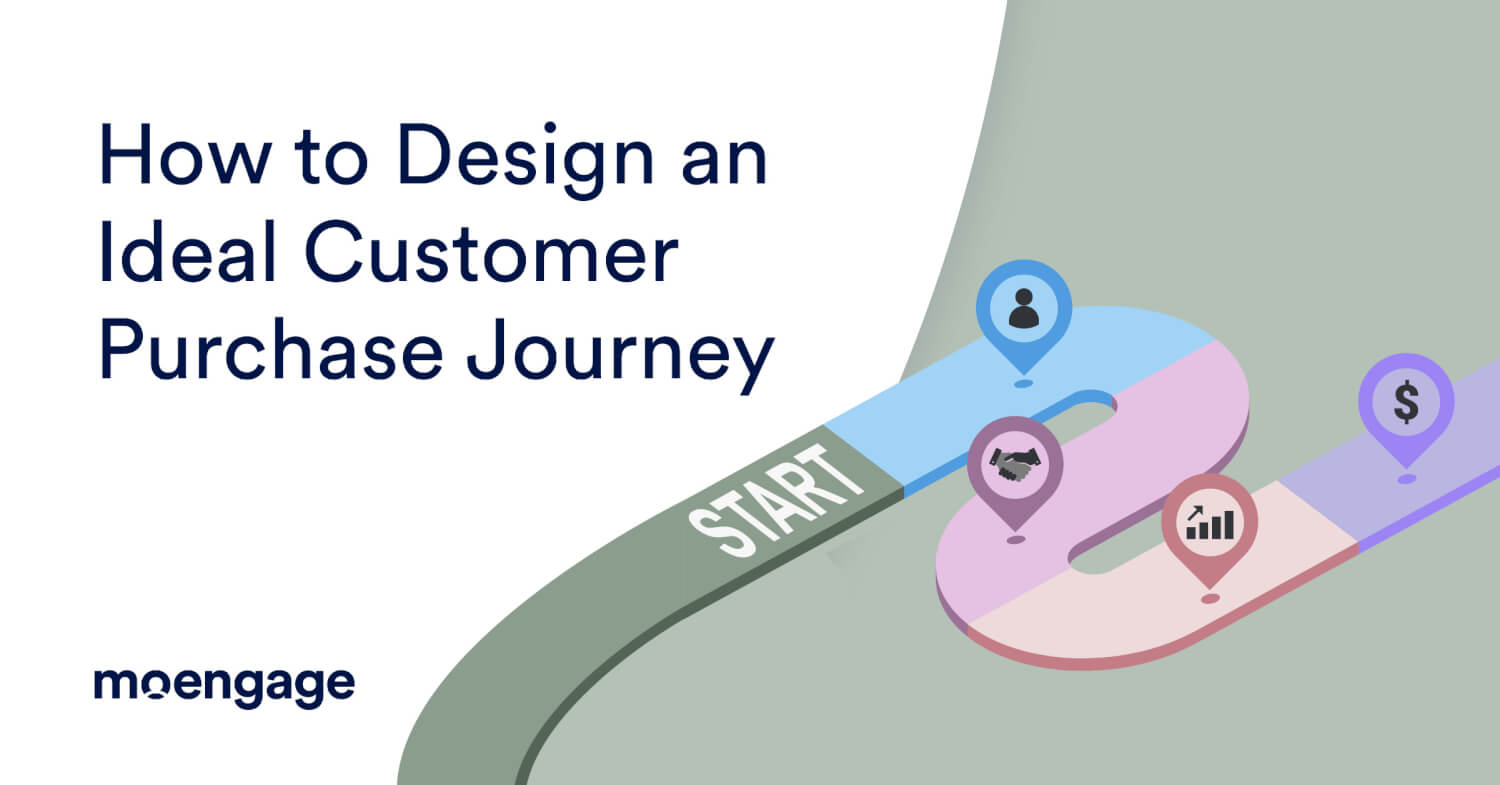
Modern customers have fleeting attention spans and an abundance of options. To drive growth and revenue, businesses need to be able to harness this attention and quickly convert it into sales.
To that end, many brands enable omnichannel shopping experiences so customers can interact on their preferred channel and develop highly personalized buying experiences to better address unique customer needs.
Since customers are quick to leave if they face friction in the purchase process, it’s critical brands orchestrate smooth omnichannel customer purchase journeys that guide customers from the awareness stage through to the decision stage, culminating in a conversion.
To help brands do just that, we explore customer purchase journeys, including what they are, how they differ from the broader customer journey, and how to build data-driven customer journeys that drive engagement and elicit conversions.
What is the Customer Purchase Journey?
The customer purchase journey, or buyer journey, is the process customers go through, from discovering a product or service for the first time to making a purchase decision. It’s the portion of the overall customer journey that’s focused exclusively on attracting leads and generating sales conversions.
Beginning at the customer’s first interaction with your brand and ending after their first purchase decision, the buyer journey encompasses the first three stages of the customer journey: awareness, consideration, and decision. Generally, the customer identifies a need, researches products and services that address this need, considers and compares options, and then makes a final purchase decision.
While “purchase journey” or “buyer journey” are often used interchangeably with the term “customer journey,” they aren’t the same. We explore the nuances in more detail in the next section.
Buyer Journey vs Customer Journey: What’s the Difference?
The buyer journey is focused exclusively on the prospective customer’s pathway to becoming a first-time purchaser. The customer journey, however, encompasses the entire customer lifecycle (from discovery to post-purchase engagement).
While both processes involve mapping customer journeys, the customer journey includes all five stages (see below), whereas the buyer journey typically ends at the decision stage. Therefore, The buyer journey makes up a smaller, more focused portion of the overall customer journey.
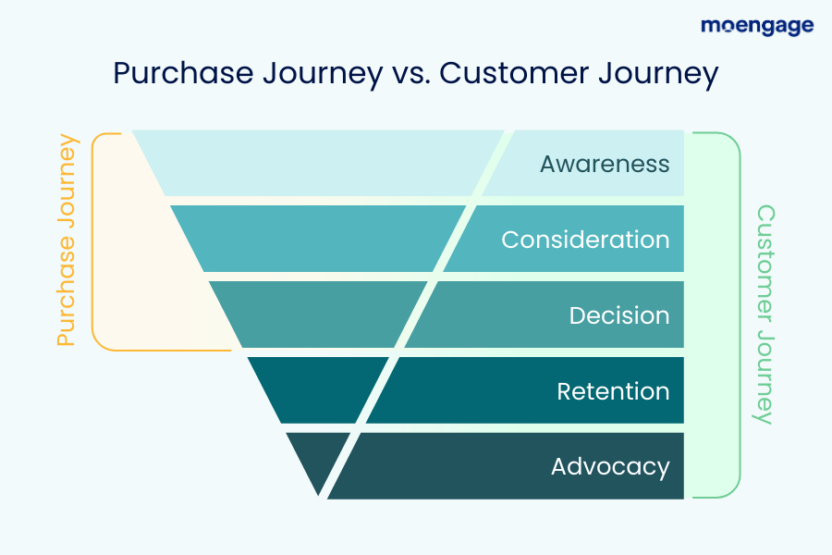
During the purchase journey, brands focus on streamlining the buying process to reduce friction so customers can complete a conversion in as few steps as possible. Throughout the customer journey, brands are focused on overall customer satisfaction, building long-term retention, and fostering brand loyalty.
In general, brands use the purchase journey to acquire customers and make sales, and they use the customer journey to retain, engage, and bond with customers more effectively.
How to Build a Value-Driven Customer Purchase Journey
To effectively engage customers and get them to finish a sale, brands need to craft seamless purchase journeys that make the shopping and buying process fast and easy for customers. This includes removing bottlenecks and mitigating friction to ensure it’s convenient for customers to complete an order.
But this is a lot easier said than done, especially when you’re operating at scale and trying to craft different experiences for your various customer segments.
Below, we look at the six core steps businesses of any industry can use as a foundation to build (and maintain) data-driven customer purchase journeys that maximize engagement and conversions.
1. Audit your existing customer purchase journey
Whether you’ve planned it or not, if you’re operating a business, you already have a customer purchase journey. It may not perform flawlessly (or even be functional), but it’s there. What you need to do is make it better so it drives more conversions.
Such an overhaul starts with a deep analysis of the existing customer purchase journey so you understand how customers browse, shop, and buy from your brand. Effective user path analysis like this provides invaluable insights into customer behavior. Look for potential shortcomings in the existing framework by identifying steps with a high drop-off rate or friction leading to bottlenecks.
Be sure to consult with both internal and external stakeholders to gain insight into the hits and misses. Your sales, product, and marketing teams have invaluable — and varied — insights into how customers understand, use, and appreciate your products or services. Be sure to lean on different stakeholders to identify frequently occurring or high-impact pain points, as well as to get actionable pointers on how to monetize the customer journey better.
2. Establish clear goals and objectives (centered on conversions)
Despite your best efforts, customers won’t always take the conversion paths you lay out for them. Customers have different needs, wants, and motivators, and therefore interact uniquely with your brand, finding their own ways of shopping for your products. The customer journeys you create must be intensely focused on key customer objectives.
In particular, buyer journeys are hyper-focused on finalizing sales. This often involves a completed purchase, but it can also mean a renewed subscription. When brands develop their customer purchase journeys, they need to focus intently on the conversion goal they are working towards and build their journeys around this specific objective. In most cases, it’s best to create unique buyer journeys for different conversion goals.
At this stage, it’s important to think critically about how you’re going to measure the success of your purchase journeys. Choose the metrics you’ll use to track performance and define how you’ll use them to measure success, develop actionable insights, and make meaningful improvements.
3. Profile different buyer personas
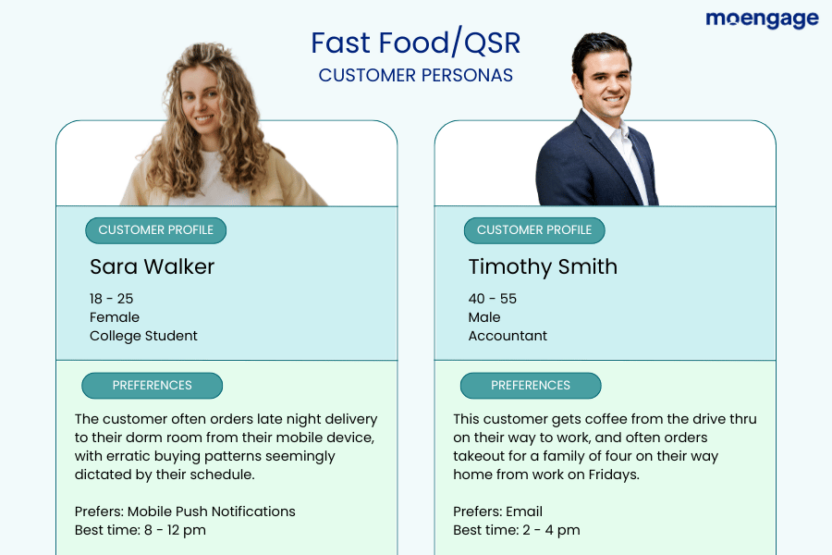
By this point, you have clearly defined goals for your customer journeys. But to make sure you create purchase journeys that your customers love, you need to build them around carefully curated buyer personas that capture your different customer segments. It’s crucial to consider your buyer personas before building or updating the customer journeys themselves to ensure they speak to your different customer segments.
Customers can be segmented by geographic and demographic characteristics, as well as personal preferences and behavioral habits. Using this information, customers can be segmented based on their shopping activity and buyer intent, enabling you to create groups like “Champions,” “Needs Attention,” “Price Sensitive,” and more. This allows you to hone in on these segments with carefully crafted campaigns that speak to their unique needs and buying triggers.
Once you’ve crafted your most common buyer personas, you can begin to think about how these customers interact with your brand. What does this group’s ideal customer journey look like? How could they have found your brand? What changes in the customer journey can enhance the customer experience? What kind of marketing efforts drive the desired outcomes? What is the average customer lifecycle, and how can you elongate it?
The answer to these questions will help you build customer journeys that are ideally suited to your customer’s unique buyer personas. When done properly, this will empower you to reach and engage your target buyer personas more effectively.
4. List, prioritize, and map out all purchase journey touchpoints
Now that you know the conversion goal you’re guiding customers toward and the buyer personas you’re targeting, it’s time to plan out your buyer journeys.
Before you actually map out which touchpoints you use and how you’ll deploy them, make sure you start with a list of all the potential touchpoints at your disposal. Knowing which touchpoints are available will allow you to build a customer purchase journey that engages customers effectively without overwhelming them or overusing channels.
While having fewer touchpoints than required can pose accessibility issues, having too many touchpoints is a common sign that your customer journey is overly complex. Brands need to find this balance to craft a perfectly optimized omnichannel customer journey. But that balance is difficult to strike when it’s different from industry to industry, niche to niche, and business to business.
Using omnichannel analytics, brands can better understand custom actions, intent, emotions, and pain points to shortlist the touchpoints that matter most. Once you have a basic understanding, you can dig deeper using cohort analysis to categorize customer segments and map their preferences for greater engagement (and success).
5. Establish — and document — the new purchase journey
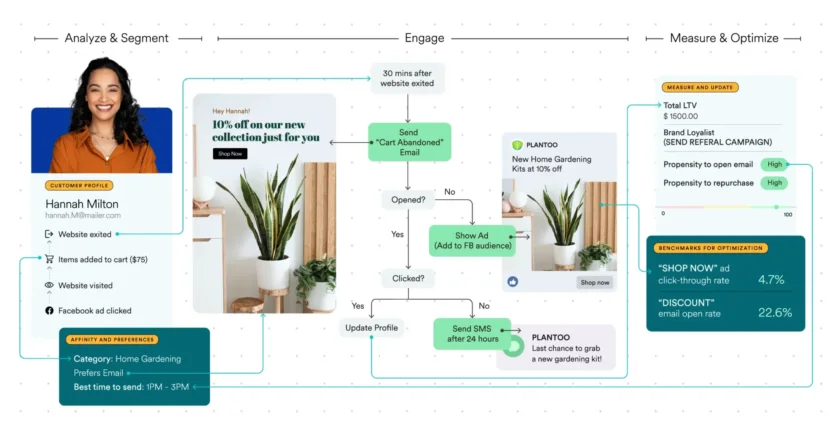
Now you’re ready to actually piece together — and implement — your purchase journey(s). When doing this, you must document the journey in a clear and discernable way for others in the team. Document all your findings, observations, and strategies surrounding the customer purchase journey. Doing so will legitimize the new and improved customer journey and guide marketing and sales reps.
Once everything is finalized, circulate the documented journey amongst the stakeholders to obtain their input and buy-in. Stakeholders from different teams should be able to align on the core objective of the purchase journey, the touchpoints being leveraged, the overall strategy, the priority channels, and the customer segments being addressed. By documenting the journey, you make it clear and accessible for all stakeholders, so each team member can ensure the journey works towards the same objective — sales.
Skip the whiteboards or presentations and use a digital tool like MoEngage to not only document the customer journey but also implement it!
6. Test, implement, and iterate the buyer journey
Alright, now you’ve finally laid out your purchase journey for customers, and it’s ready to go… almost.
Before implementing your customer journey, make sure you test it rigorously to see how it functions and how it’s received. Step inside your customer’s shoes and recreate how every customer moves across the different stages of the buyer journey. Identify what works, isolate weaknesses, and make fixes to optimize the purchase journey for greater traction and increased conversions.
Be sure to track and measure the performance of the customer journey using actionable metrics, helping you identify opportunities and pitfalls in the customer experience. Continuously optimize and reiterate to create a truly customer-centric buying journey for your customers. Keep a watchful eye on any ongoing trends that can shape buyer behavior, watch for changes to purchase paths, and continue to make tweaks to the customer journey accordingly.
When developing customer purchase journeys, focus most on closing the deal and finalizing the conversion. That being said, to build incredible customer journeys (not just buyer journeys), brands need to build customer experiences that create customer satisfaction and lead to retention.
3 Customer Buying Journey Examples From Global Brands
This all seems straightforward enough — at least in theory. But in practice, it’s extremely challenging to execute purchase journeys that deliver high conversion rates, especially when trying to personalize customer journeys at scale.
To help you craft seamless purchase journeys that ensure your customers buy, we explore real-life examples from top brands in different industries.
1. In Retail: Gymshark
Gymshark is a multinational company that has carved out its place as an apex predator in the sportswear and athleisure market. A major reason for their success as a retail and ecommerce brand is their effort to perfect their customer purchase journey.
They have a powerful awareness stage, with a solid social media presence that achieves massive outreach due to their strong emphasis on influencer marketing. Their entire web presence is heavily focused on both promoting their sportswear and athleisure apparel and building a fitness and wellness community.
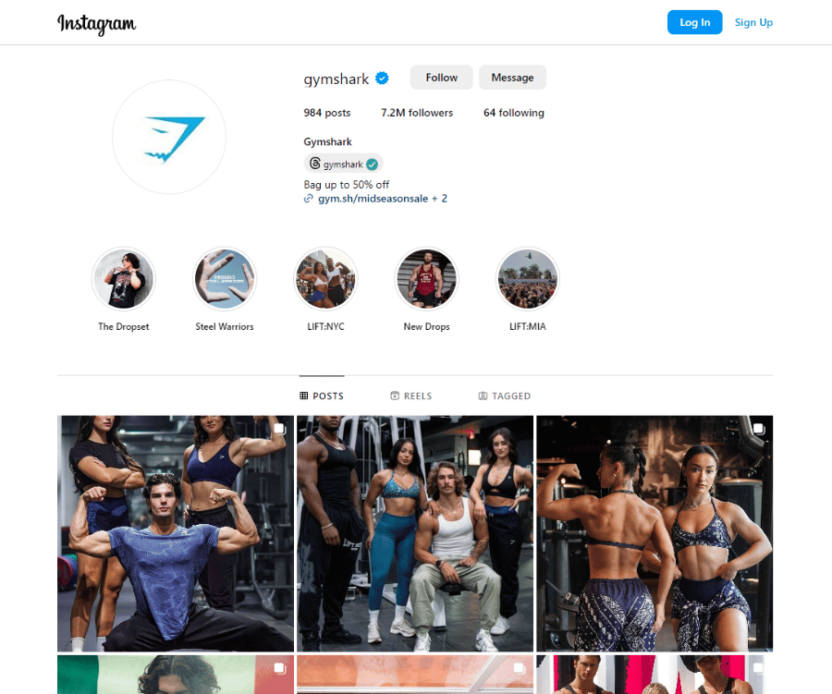
The buyer journey is hyper-focused on amplifying sales opportunities and streamlining the buying process. Customers can get carefully crafted product recommendations by filtering their shopping experience and narrowing their search to products that fit their gender or particular events.
When a customer hovers their cursor over an item while shopping on their website, the image automatically shows a reverse view of the product, so customers can easily see what the product looks like from the front and back. Customers who have added items to their cart are served relevant product recommendations. After a customer’s cart reaches a certain value, they’re automatically notified that they’ve qualified for free shipping through in-app messaging.
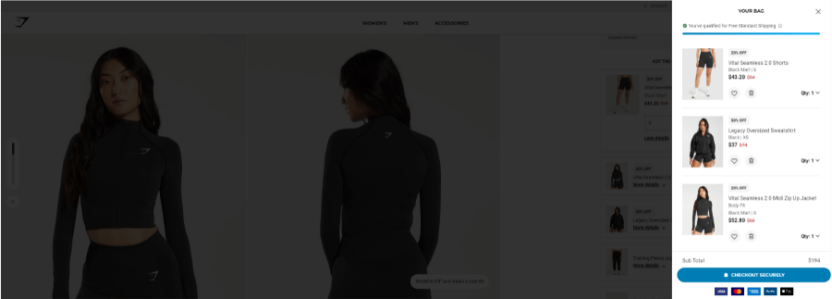
All of this creates a smooth, seamless experience for customers; one that makes completing the purchase journey extremely fast and efficient, resulting in more conversions.
Despite a heavy focus on sales, Gymshark is still thinking about how this experience fits into the overall customer journey. They aren’t just selling sportswear, they are curating an athletic lifestyle brand that customers don’t just want to buy, but want to be a part of. In the end, this dedication will lead to repeat sales and increased revenue while still driving immediate conversions.
2. In QSR: Burger King
You don’t become king without understanding and adapting to the market. To keep pace with the increasing speed of the fast food industry, Burger King has invested heavily in building an effective buyer journey for their customers.
Burger King knows that QSR and fast food customers are looking to make a quick purchase, and they want quick turnaround times with clear communication on food status for both pickup and delivery. They do all they can to make this process fast and efficient for customers, while still promoting their feature products and serving personalized recommendations that create upsell opportunities.
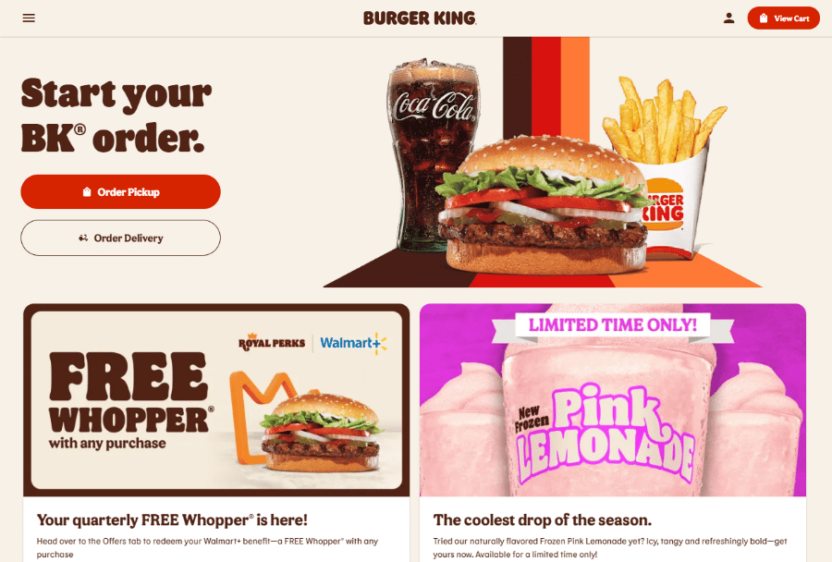
Burger King puts their online ordering options front and center, making it easy for customers to initiate a pickup or delivery order with the click of a button. They also prominently display featured products and offers on their app or website that entice customers to place an offer immediately. After the customer inputs their delivery location or chooses their closest restaurant location, the customer is given details about that location, including hours of operation and available order options.
After selecting their delivery options, customers are immediately brought to the menu screen, where they can select their items, choose sides, and add substitutions before proceeding to checkout. Once the customer has already committed, they request existing customers to sign in and ask new customers to create an account. Since new customers have already input their order, they are far more likely to complete this process than if it was served to them at the beginning, before they’d selected their items. By allowing visitors to get this far in the process, Burger King gets more customers to the checkout, increasing their conversion rate.
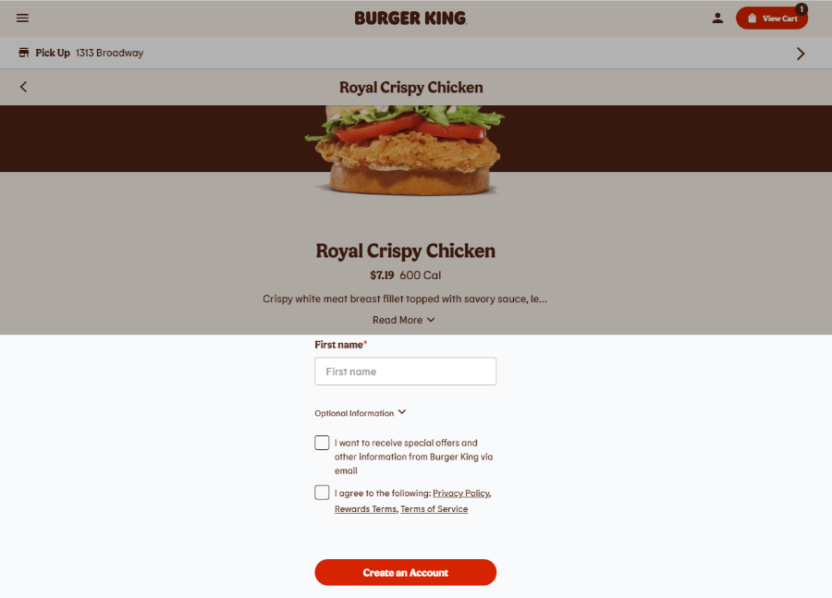
New customers can also complete registration within the checkout process, using an overlay. The customer simply signs up midway through the checkout process, and then seamlessly proceeds from where they left off. They aren’t funneled to another page, and their checkout isn’t put on hold. They don’t need to restart, enabling customers to easily and quickly complete registration and checkout.
The entire process is streamlined to make the buying experience as convenient and effortless as possible, so customers stay on track and finish their order. Burger King’s purchase journey is designed to allow customers to proceed without having to do anything more than submit their email address, giving Burger King the ability to enroll the customer in their marketing efforts. Ideally, Burger King’s royal customers are so satisfied that they become loyal customers who will come back to order again.
3. In Streaming & Entertainment: NFL
The National Football League (NFL) knows that website visitors coming to check for scores, team roster updates, player changes, and news are already interested in American football. Any of these visitors who don’t already have a subscription to watch the NFL coverage are extremely high-intent customers.
While these new visitors are likely high-intent customers, the NFL has to do a careful job of integrating advertising so they don’t overwhelm (and annoy) existing customers. To circumvent this, the NFL makes it extremely easy for customers with a subscription to sign in, enabling the NFL to avoid serving them advertising to subscribe.
The rest of the NFL’s website is geared towards marketing NFL subscription services to new customers.
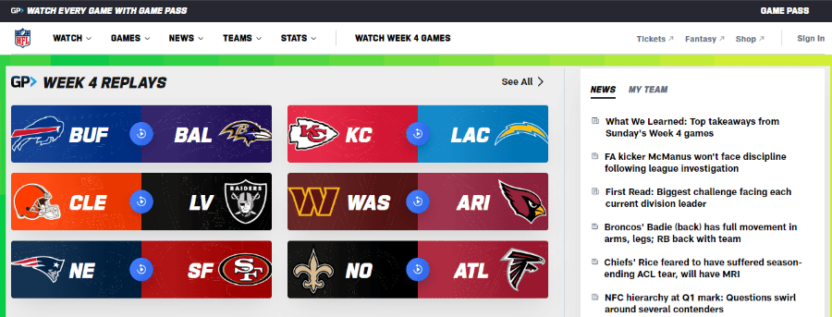
Football fans can seamlessly navigate league information from the website, including scores, game highlights, and so much more. After a week, they prominently showcase replays of the past week’s matchups. When a new visitor clicks the link, they are automatically funneled to DAZN, the streaming service the NFL has partnered with. They are then immediately served dynamic marketing messaging that offers them a discount for their first 2 months or a free trial. Once clicked, prospective customers are funneled into an onboarding sequence that signs the new customers up and initiates a checkout process for their subscription.
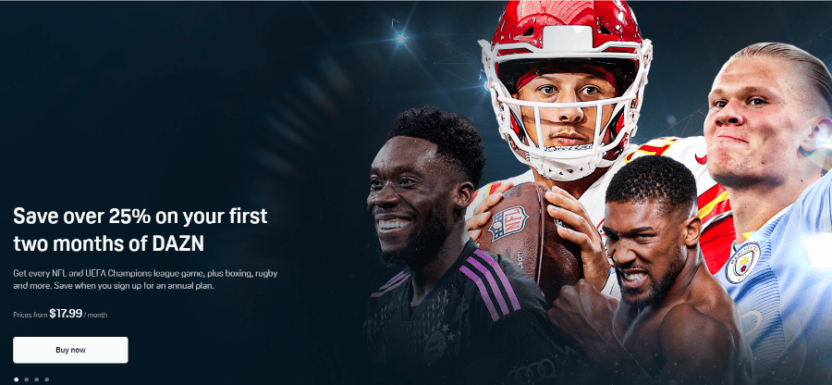
The entire process is streamlined to capture high-intent customers’ attention and funnel it quickly and effectively to a completed subscription.
Learn How to Implement an Ideal Customer Purchase Journey with MoEngage
Whether you’re in retail and ecommerce, media and entertainment, food and beverage, banking and finance, or travel and hospitality, getting customers from their first visit to a finalized purchase is crucial to success.
It’s what generates immediate sales (and keeps your business afloat) and creates a stream of revenue, but — even more significantly — it marks the moment a visitor is turned into a customer. If the customer purchase journey is crafted right, customers will not only be satisfied with this initial interaction, but they’ll be motivated to return to your brand for future business
MoEngage helps brands orchestrate seamless customer purchase journeys that turn visitors into buyers. Our omnichannel marketing approach ensures customers are activated with the right messaging, at the right time, and on the ideal channel to maximize engagement and get customers to complete their conversion.
We don’t just stop there though; we also help you orchestrate engaging post-purchase experiences that retain customers, build brand loyalty, and incentivize repeat purchases. Schedule a demo with a product expert to learn how we can help you build impactful, memorable buyer journeys — and overall experiences — for your customers.












